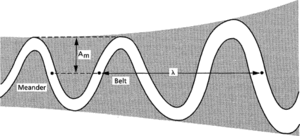The sinuous trace of a stream channel whose length is normally equal to or greater than 1.5 times the down-valley (or straight-line) distance. It is best developed in cohesive floodplain alluvium. The relationships between its geometric properties vary little with size: e.g. meander wavelength (the straight-line distance between two points at similar positions (e.g. outward extremities of curve) on two successive curves along the trace) is normally 10–14 times the channel width, irrespective of size. Meander origin is uncertain, but the sinuous curve may be that shape best fitted for the transfer of channelled flow in accordance with the least work principle. Over time, a meander may move laterally and/or vertically. The process of sideways movement is known as ‘meander migration’; it involves the deposition of point bars on the inner sides of bends and erosion on the outer, and is limited to a tract of floodplain called the ‘meander belt’. The migration of two adjacent, concave bands may narrow the floodplain between them, and the restriction is a ‘meander neck’. This widens out to form a bulbous feature, the ‘meander core’, around which the river swings. The surface of a core may show ‘meander scrolls’, which are low, curved ridges of relatively coarse material lying parallel to the main channel and deposited by the stream. An ‘incised meander’ results from downcutting, and two types are found. (a) If incision is fairly slow, and sideways movement occurs, the result is an ‘ingrown meander’. The slope down which the stream has migrated during incision is called a ‘slip-off slope’. (b) When incision is rapid, with mainly vertical erosion, the consequence is an ‘entrenched meander’.
A winding curve in the course of a river. A sinuosity of above 1.5 is regarded as distinguishing a meandering channel from a straight one. The dimensions of a meander are related to the square root of water discharge, Q:
where λ is meander wavelength, Am is meander amplitude, wc is the channel width, and k1, k2, and k3 are coefficients whose value varies with location. Bank resistance controls meander wavelength, and is positively correlated with meander wavelength (Abrahams (1985) ESPL 10, 6). Meander bends with a low radius of curvature have deeper pools and more lateral migration; the ensuing bank erosion reduces pool depth via higher sediment inputs. Meander bends with smaller pools have less lateral migration, but use energy vertically, thereby deepening pools and fostering pool-riffle sequences (Hudson (2002) Phys. Geog. 23, 2).Eaton et al. (2006) ESPL 31 argue that slight initial variations in the shear stress distribution result in local net scour along the banks, increasing local transport capacity. In a positive feedback, this leads to further local net scour, which is mostly vertical until the channel banks begin to fail, at which point bank erosion triggers negative feedback that increases channel sinuosity. Once one initial bend develops, others inevitably follow; see also Parker et al. (2011) ESPL 36, 1, 70 for a new model of river meandering. See Millar (2005) Geomorph. 64 on equations for the meandering–braiding transition, and Pittaluga and Seminara (2011) ESPL 36, 1, 20 on nonlinearity and unsteadiness in river meandering. The meander belt is the total width across which the river meanders.

Meander
- is
- ISA
- Isaac Newton Group
- Isaac Newton Telescope
- Isaacs, Alick
- Isabella I (1451–1504)
- Isabella II (1830–1904)
- Isabella of France (1292–1358)
- Isaiah (8th century)
- ISAM
- Isandhlwana, Battle of (22 January 1879)
- ISAS
- ISBA
- ISCB
- ISCCP
- ischium
- ISC Kosmotras
- IS curve
- ISDN
- ISEE
- isentropic
- isentropic (isentropic surface)
- isentropic process
- ISF
- Ishmael effect